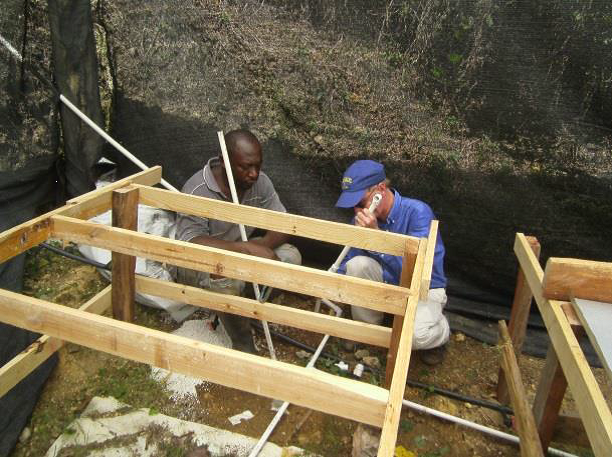Hydroponics and the Santoy Farmers Cooperative
Last month, F2F volunteers Tom Evans and Wally Pill traveled
to Jamaica to assist the Santoy Farmers Cooperative in establishing a
hydroponic system for their microgreen production.
The following includes excerpts from Dr. Evans’ and Dr. Pill’s
joint trip report:
 |
| Constructing the hydroponic system. |
“This cooperative, under the leadership of Mr. Milton
Murdock, has expanded their production of microgreen vegetables over the last
several years. More and more resorts and restaurants are being served by the
Cooperative. […] One of the major costs in microgreen production is the cost of
the substrate in which the microgreens are grown. Since there are no locally
produced substrates that the cooperative could use, peat-based substances from
overseas must be imported. Such substrates are very expensive. One way to
reduce the cost of microgreen production is therefore to eliminate the need for
peat-based substrates and produce the microgreens hydroponically. Hydroponics
has many forms, but the form chosen for the Santoy Cooperative is the
Nutrient Film Technique (NFT). In this system, a diluted solution containing all
the essential nutrient elements for plant growth is run down a sloping trough
in a thin film. The plants are raised on some sort of inert material placed in
the trough. This inert material varies greatly, but can be phenolic foam or
rockwool cubes or matting. For microgreens, matting is used, but the choice of
matting material is a critical concern. Normally the effluent from the lower
end of the trough is collected and recycled through the trough system.”
 |
| Roots ramified the burlap to anchor the microgreens. |
Dr. Evans and Dr. Pill worked with the Cooperative to
construct the NFT system. Steps included constructing benches that could
support the troughs, installing electrical and plumbing components, and
selecting the type of matting to use in the trough. Each part of the process
required some trial and error to best customize the NFT system to the Santoy
Cooperative’s needs. Matting, for example, “needs to prevent seeds from moving
with the flow of nutrients solution down the trough, must be able to retain
sufficient moisture to support plant growth between irrigations, and must also
be economical.” To determine which type of matting would work best, the F2F
volunteers and Santoy Cooperative members set up a small experiment using four
different types of matting in four different troughs. They found that the most
effective matting material was either burlap or a wick mat depending on species
of crop and size of need.
 |
| Baby salad lettuce. |
In light of increased local demand for baby salad lettuce,
Mr. Murdock also requested that F2F volunteers assist the Cooperative in
lettuce production. Dr. Evans and Dr. Pill worked with producers to sow the
lettuce seeds in plug trays, select the appropriate nutrient solution and calculate
the nutrient needs of plants in the troughs. By improving and increasing
production of microgreens and slightly larger plants like baby salad lettuce,
the Santoy Cooperative can more effectively penetrate the direct sales market
of its products, selling directly to resorts or high-end restaurants rather
than selling to brokers.

.png)

Comments
Post a Comment